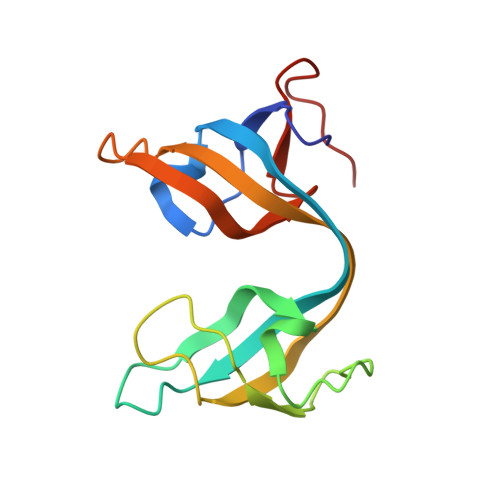The copBL operon protects Staphylococcus aureus from copper toxicity: CopL is an extracellular membrane-associated copper-binding protein.
Rosario-Cruz, Z., Eletsky, A., Daigham, N.S., Al-Tameemi, H., Swapna, G.V.T., Kahn, P.C., Szyperski, T., Montelione, G.T., Boyd, J.M.(2019) J Biol Chem 294: 4027-4044
- PubMed: 30655293
- DOI: https://doi.org/10.1074/jbc.RA118.004723
- Primary Citation of Related Structures:
2KY9 - PubMed Abstract:
As complications associated with antibiotic resistance have intensified, copper (Cu) is attracting attention as an antimicrobial agent. Recent studies have shown that copper surfaces decrease microbial burden, and host macrophages use Cu to increase bacterial killing. Not surprisingly, microbes have evolved mechanisms to tightly control intracellular Cu pools and protect against Cu toxicity. Here, we identified two genes ( copB and copL ) encoded within the Staphylococcus aureus arginine-catabolic mobile element (ACME) that we hypothesized function in Cu homeostasis. Supporting this hypothesis, mutational inactivation of copB or copL increased copper sensitivity. We found that copBL are co-transcribed and that their transcription is increased during copper stress and in a strain in which csoR , encoding a Cu-responsive transcriptional repressor, was mutated. Moreover, copB displayed genetic synergy with copA, suggesting that CopB functions in Cu export. We further observed that CopL functions independently of CopB or CopA in Cu toxicity protection and that CopL from the S. aureus clone USA300 is a membrane-bound and surface-exposed lipoprotein that binds up to four Cu + ions. Solution NMR structures of the homologous Bacillus subtilis CopL, together with phylogenetic analysis and chemical-shift perturbation experiments, identified conserved residues potentially involved in Cu + coordination. The solution NMR structure also revealed a novel Cu-binding architecture. Of note, a CopL variant with defective Cu + binding did not protect against Cu toxicity in vivo Taken together, these findings indicate that the ACME-encoded CopB and CopL proteins are additional factors utilized by the highly successful S. aureus USA300 clone to suppress copper toxicity.
Organizational Affiliation:
From the Department of Biochemistry and Microbiology, Rutgers, the State University of New Jersey, New Brunswick, New Jersey 08901.














